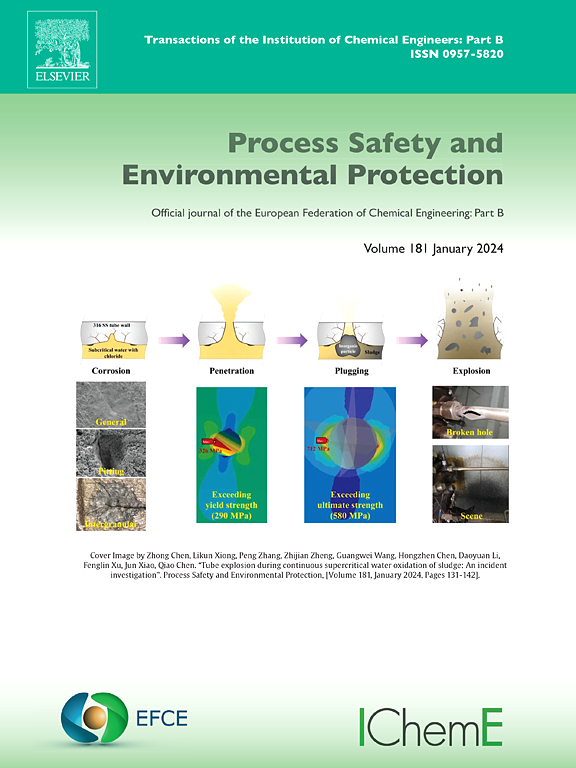抗生素对废水反硝化作用的研究进展:从过程抑制到微生物耐药机制
IF 7.8
2区 环境科学与生态学
Q1 ENGINEERING, CHEMICAL
引用次数: 0
摘要
抗生素作为一种新兴污染物,在废水处理系统中经常被检测到,其对生物反硝化的影响越来越受到人们的关注。本文综合考虑抗生素种类、浓度、环境条件和暴露时间等因素,综述了抗生素对异养、自养和混合养反硝化性能的影响。它深入研究了抗生素对硝酸盐去除、中间产物积累和温室气体排放的影响。本文还从反硝化微生物群落结构和功能基因的角度阐述了这些作用的机制。此外,它还阐明了微生物对抗抗生素作用的防御机制,如生物降解、细胞外聚合物(EPS)分泌和抗生素抗性基因(ARGs)获取。这些机制使微生物能够在抗生素压力下保持反硝化能力。最后,综述指出了当前研究的不足之处,并提出了未来的研究方向,强调需要在低浓度抗生素、综合污染效应、微生物适应机制和ARGs传播途径等方面进行研究。本文章由计算机程序翻译,如有差异,请以英文原文为准。
A review of antibiotic effects on wastewater denitrification: From process inhibition to microbial resistance mechanism
Antibiotics, as emerging pollutants, are frequently detected in wastewater treatment systems, and their impact on biological denitrification has garnered increasing attention. This review comprehensively summarized the effects of antibiotics on heterotrophic, autotrophic, and mixotrophic denitrification performances, considering various factors such as antibiotic types, concentrations, environmental conditions and exposure time. It delves into antibiotic effects on nitrate removal, intermediate product accumulation, and greenhouse gas emissions. The review also elucidates the mechanisms underlying these effects from the angles of denitrifying microbial community structures and functional genes. Furthermore, it clarifies the defense mechanisms employed by microorganisms to counteract antibiotic effects, such as biodegradation, extracellular polymeric substance (EPS) secretion, and antibiotic resistance genes (ARGs) acquisition. These mechanisms enable microorganisms to maintain denitrification capabilities under antibiotic pressure. Finally, the review identifies gaps in current research and suggest future directions, emphasizing the need for studies on low-concentration antibiotics, combined pollution effects, microbial adaptation mechanisms, and ARGs dissemination pathways.
求助全文
通过发布文献求助,成功后即可免费获取论文全文。
去求助
来源期刊

Process Safety and Environmental Protection
环境科学-工程:化工
CiteScore
11.40
自引率
15.40%
发文量
929
审稿时长
8.0 months
期刊介绍:
The Process Safety and Environmental Protection (PSEP) journal is a leading international publication that focuses on the publication of high-quality, original research papers in the field of engineering, specifically those related to the safety of industrial processes and environmental protection. The journal encourages submissions that present new developments in safety and environmental aspects, particularly those that show how research findings can be applied in process engineering design and practice.
PSEP is particularly interested in research that brings fresh perspectives to established engineering principles, identifies unsolved problems, or suggests directions for future research. The journal also values contributions that push the boundaries of traditional engineering and welcomes multidisciplinary papers.
PSEP's articles are abstracted and indexed by a range of databases and services, which helps to ensure that the journal's research is accessible and recognized in the academic and professional communities. These databases include ANTE, Chemical Abstracts, Chemical Hazards in Industry, Current Contents, Elsevier Engineering Information database, Pascal Francis, Web of Science, Scopus, Engineering Information Database EnCompass LIT (Elsevier), and INSPEC. This wide coverage facilitates the dissemination of the journal's content to a global audience interested in process safety and environmental engineering.
 求助内容:
求助内容: 应助结果提醒方式:
应助结果提醒方式:


